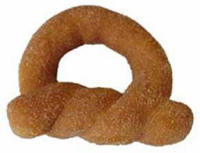Nonnevot
Nonnevot[edit | edit source]
The nonnevot is a traditional pastry originating from the Limburg region in the Netherlands. It is particularly associated with the city of Sittard, where it is commonly enjoyed during the Carnival season. The name "nonnevot" translates to "nun's buttocks" in the local dialect, a reference to the pastry's distinctive shape.
History[edit | edit source]
The nonnevot has a long history in Limburgian culture, with its origins dating back several centuries. It is traditionally prepared during the festive period leading up to Lent, a time when rich and indulgent foods are consumed before the fasting season. The pastry's unique name is believed to have been inspired by its resemblance to the folds of a nun's habit.
Ingredients and Preparation[edit | edit source]
The main ingredients of a nonnevot include flour, yeast, butter, sugar, and eggs. The dough is prepared by mixing these ingredients to form a smooth, elastic consistency. Once the dough has risen, it is shaped into a knot or bow-like form, which is characteristic of the nonnevot.
After shaping, the nonnevot is deep-fried until golden brown. It is then dusted with powdered sugar before serving. The result is a sweet, fluffy pastry with a slightly crispy exterior.
Cultural Significance[edit | edit source]
In Limburg, the nonnevot is more than just a pastry; it is a symbol of regional identity and tradition. During the Carnival season, bakeries throughout the region produce large quantities of nonnevots to meet the demand from locals and tourists alike. The pastry is often enjoyed with a cup of coffee or tea, and it is a staple at Carnival celebrations.
Related Pages[edit | edit source]
Search WikiMD
Ad.Tired of being Overweight? Try W8MD's physician weight loss program.
Semaglutide (Ozempic / Wegovy and Tirzepatide (Mounjaro / Zepbound) available.
Advertise on WikiMD
|
WikiMD's Wellness Encyclopedia |
| Let Food Be Thy Medicine Medicine Thy Food - Hippocrates |
Translate this page: - East Asian
中文,
日本,
한국어,
South Asian
हिन्दी,
தமிழ்,
తెలుగు,
Urdu,
ಕನ್ನಡ,
Southeast Asian
Indonesian,
Vietnamese,
Thai,
မြန်မာဘာသာ,
বাংলা
European
español,
Deutsch,
français,
Greek,
português do Brasil,
polski,
română,
русский,
Nederlands,
norsk,
svenska,
suomi,
Italian
Middle Eastern & African
عربى,
Turkish,
Persian,
Hebrew,
Afrikaans,
isiZulu,
Kiswahili,
Other
Bulgarian,
Hungarian,
Czech,
Swedish,
മലയാളം,
मराठी,
ਪੰਜਾਬੀ,
ગુજરાતી,
Portuguese,
Ukrainian
Medical Disclaimer: WikiMD is not a substitute for professional medical advice. The information on WikiMD is provided as an information resource only, may be incorrect, outdated or misleading, and is not to be used or relied on for any diagnostic or treatment purposes. Please consult your health care provider before making any healthcare decisions or for guidance about a specific medical condition. WikiMD expressly disclaims responsibility, and shall have no liability, for any damages, loss, injury, or liability whatsoever suffered as a result of your reliance on the information contained in this site. By visiting this site you agree to the foregoing terms and conditions, which may from time to time be changed or supplemented by WikiMD. If you do not agree to the foregoing terms and conditions, you should not enter or use this site. See full disclaimer.
Credits:Most images are courtesy of Wikimedia commons, and templates, categories Wikipedia, licensed under CC BY SA or similar.
Contributors: Prab R. Tumpati, MD

